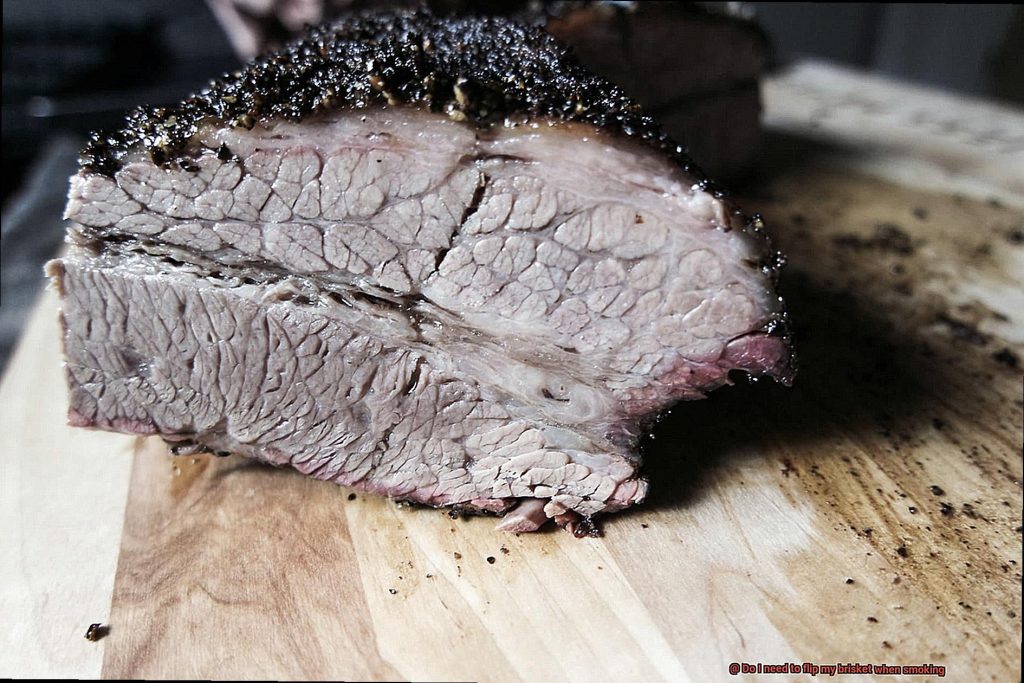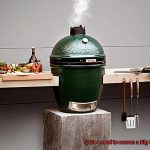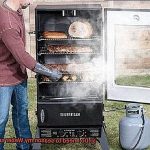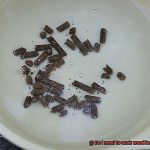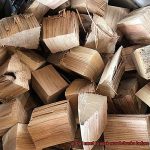Imagine this: a thick fog of smoke enveloping your backyard, the mouthwatering scent of perfectly smoked meat wafting through the air. Ah, the magic of smoking a brisket. But in the midst of all the excitement, a burning question arises: should you flip that glorious slab of meat halfway through the smoking process, or just let it be?
As someone who’s obsessed with all things smoky and delicious, this age-old debate has piqued my curiosity for years. Today, we embark on an adventure to uncover the pros and cons of flipping that brisket while it smokes. Get ready for a thrilling exploration of technique, science, and flavor – all aimed at unlocking the secrets to achieving brisket perfection.
Join me as we shine a light on whether flipping is a subtle culinary maneuver that leads to smoky nirvana or simply a passing trend. Together, we’ll dive deep into the world of mesmerizing smoke rings, melt-in-your-mouth meat, and unparalleled flavors. In the end, we’ll determine if this brisket-flipping saga is just folklore or cold hard truth. So grab your aprons, fire up those smokers, and let’s get our hands smokin’.
Contents
What is Flipping a Brisket?
Like the clash of titans, pitmasters and backyard grillers square off on opposite sides, each armed with their own arsenal of arguments. Join us as we dive into the depths of this fiery dispute and uncover the secrets behind flipping a brisket.
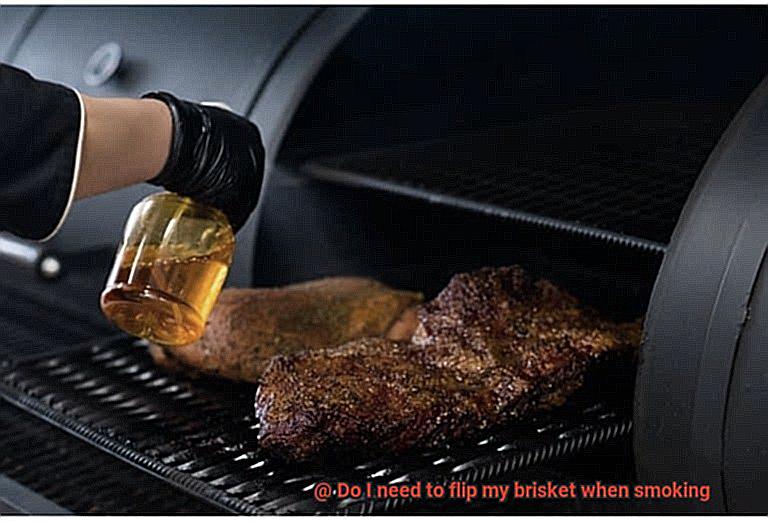
The Case for Flipping:
- Even Cooking: Flipping a brisket ensures that both sides receive an equal share of the smoky goodness, resulting in a tender and evenly cooked masterpiece.
- Bark Development: By flipping, you can achieve a balanced and mouthwatering bark on both sides of the brisket. This flavorful crust adds depth and character to every bite.
- Moisture Management: Flipping helps prevent excessive moisture buildup on the bottom side of the brisket, keeping it succulent without sacrificing tenderness.
The Case Against Flipping:
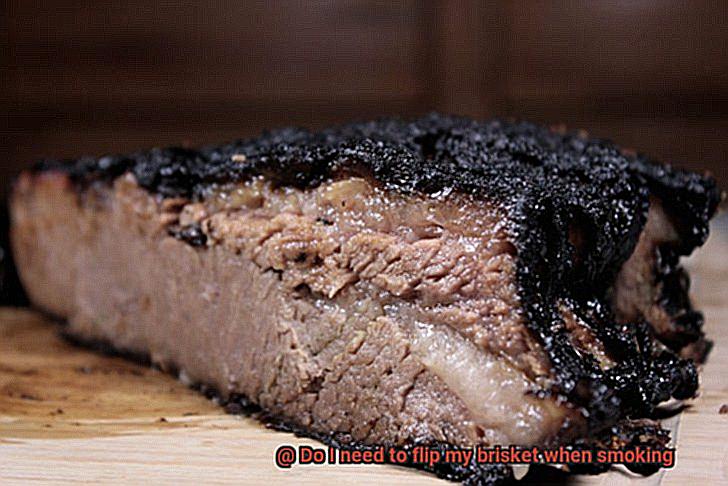
- Heat Disruption: Each flip opens the door to temperature fluctuations, potentially wreaking havoc on your cooking process. The risk of losing heat control becomes a battle against time and precision.
- Juices Preservation: With every flip, precious juices can escape, leaving your brisket drier than the Sahara. The loss can be devastating, especially when you’ve painstakingly crafted the perfect balance of flavors.
- Bark Disturbance: Flipping can disrupt the formation of that coveted bark on the surface of your brisket. Once disturbed, it’s hard to regain that perfect blend of spice, smoke, and texture.
Pros and Cons of Flipping a Brisket
Flipping a brisket while smoking it is a hotly debated topic among pitmasters. Some swear by the technique, claiming that it leads to a more evenly cooked and tender end result, while others argue that flipping is unnecessary and can disrupt the cooking process. So, what are the pros and cons of flipping a brisket?
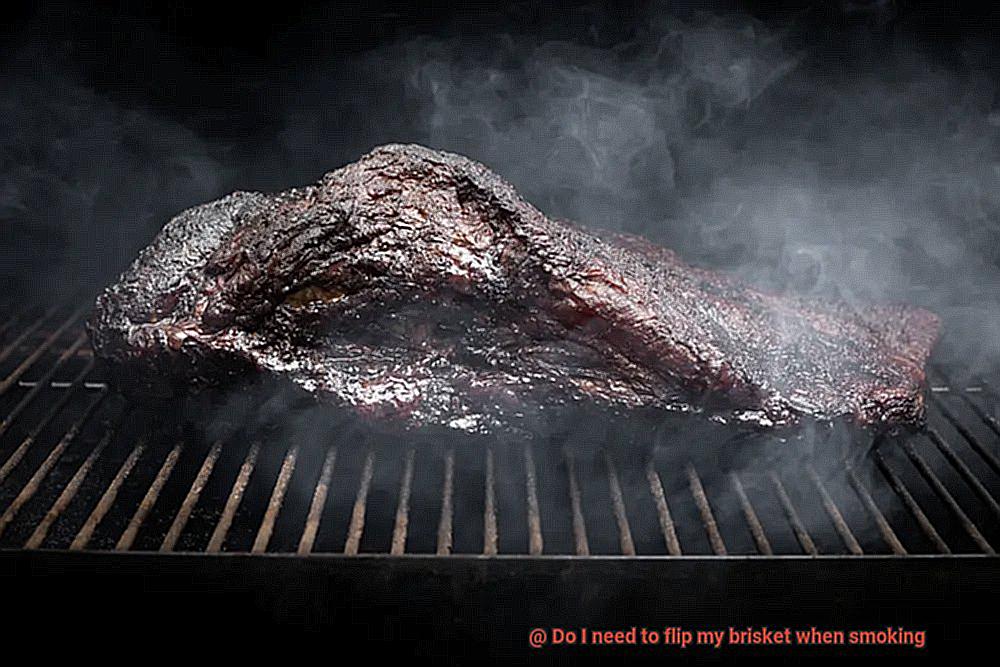
Let’s start with the pros. One of the main reasons proponents of flipping suggest doing so is to achieve more even cooking throughout the brisket. By flipping the meat, you ensure that both sides are exposed to the heat source and smoke, reducing the risk of uneven cooking or hot spots. This can result in a more consistent and balanced flavor profile.
But that’s not all. Another advantage of flipping is enhanced bark development. The bark, that beautifully caramelized crust on the exterior of a smoked brisket, is highly sought after by barbecue enthusiasts. Flipping the brisket can help promote the development of a deep and flavorful bark on both sides of the meat, as it allows for more exposure to smoke and heat. This can add an extra layer of complexity and depth to your finished product.
And let’s not forget about moisture retention. Flipping a brisket during the smoking process can also help with this. As the meat cooks, its natural juices tend to collect on the side facing up. But by flipping it, you allow those juices to redistribute, preventing one side from becoming overly dry while enhancing overall tenderness and juiciness.
However, there are some cons to consider as well. One of the primary arguments against flipping a brisket is that it can disrupt the cooking time and potentially extend it. When you open the smoker to flip the meat, you lose heat and smoke, which can lead to fluctuations in temperature and hinder the overall cooking process. This can result in a longer cook time, potentially affecting the tenderness and texture of the brisket.
Another drawback is the risk of the meat falling apart. Brisket is a notoriously tough cut of meat that requires low and slow cooking to break down its connective tissues and achieve that desired tenderness. Flipping the brisket increases the risk of it falling apart, especially if it is not adequately supported or handled with care. This can be particularly problematic for larger briskets or those nearing the end of their cooking time.
Lastly, there is a potential loss of seasoning when flipping a brisket. There is a chance that some of the seasoning or rub applied to the top side may come off or stick to the cooking surface. This can result in a loss of flavor and potentially leave one side less seasoned than the other. It’s important to consider this potential drawback when deciding whether to flip your brisket.
Factors to Consider When Deciding Whether to Flip a Brisket
The decision of whether or not to flip a brisket during the cooking process is a critical one that can greatly impact the final result. To make an informed choice, several factors need to be taken into consideration:
- Size and Thickness: The size and thickness of the brisket are crucial factors to consider when determining whether flipping is necessary. A thick brisket may require flipping to ensure even cooking throughout. Uneven cooking can result in one end being overcooked while the other remains tough. Conversely, smaller or thinner cuts may cook evenly without the need for flipping.
- Cooking Method: The chosen cooking method also plays a role in the decision to flip a brisket. If you’re using a low and slow method with indirect heat, flipping may not be essential. The gentle heat will circulate around the brisket, ensuring tenderness and juiciness. However, if you’re grilling at high heat, flipping can help prevent charring or burning while promoting even cooking.
- Equipment and Setup: The type of equipment and setup used can influence the need for flipping. If you have a charcoal grill with uneven heat distribution, flipping can compensate for hot spots, ensuring that every inch of the brisket receives equal attention. Similarly, if your smoker has inconsistent airflow, flipping can help achieve a perfect balance of tenderness and flavor.
- Personal Preference: Personal preference is an important factor when deciding whether to flip a brisket. Some pitmasters argue that flipping enhances bark development and creates a more balanced flavor and texture. Others believe that flipping leads to moisture loss and compromises the meat’s juiciness. Ultimately, it’s up to individual experimentation to find what works best for personal taste preferences.
- Time Constraints: Time constraints should also be considered when deciding whether to flip a brisket. Flipping requires extra attention and effort during the cooking process. If you’re short on time or prefer a more hands-off approach, skipping the flip might be the better choice. However, flipping can help achieve consistent results, especially if you’re aiming for a perfectly cooked and flavorful brisket.
- Bark Development: The development of a flavorful crust, known as the bark, is a desirable outcome when smoking brisket. Flipping the brisket can expose it to direct heat, enhancing the formation of the bark and adding smoky goodness. If a well-developed bark is a priority, flipping can be a secret weapon in achieving that desired result.
- Experience Level: Consider your experience level as a pitmaster. If you’re new to smoking briskets, flipping can provide better control over the cooking process and help avoid potential mistakes. As you gain more experience and confidence, you can experiment with different techniques, including flipping or not flipping, based on personal preferences and desired results.
The Right Time to Flip a Brisket
It’s a question that has sparked debates among pitmasters and backyard grillers alike. But fear not, my fellow barbecue enthusiasts, for I am here to shed some light on this smoky dilemma.
First and foremost, let’s establish that flipping a brisket while smoking is not always necessary. However, it can be a game-changer if you’re aiming for that perfect balance of tender meat and a smoky crust. So, if you’re up for the challenge, here’s what you need to know.
The decision to flip or not to flip depends on a few factors: your cooking method, the type of smoker you’re using, and, of course, your personal preference. If you’re rocking a traditional offset smoker, where the heat source is on one side, flipping that bad boy ensures even cooking and prevents any side from getting too crispy.
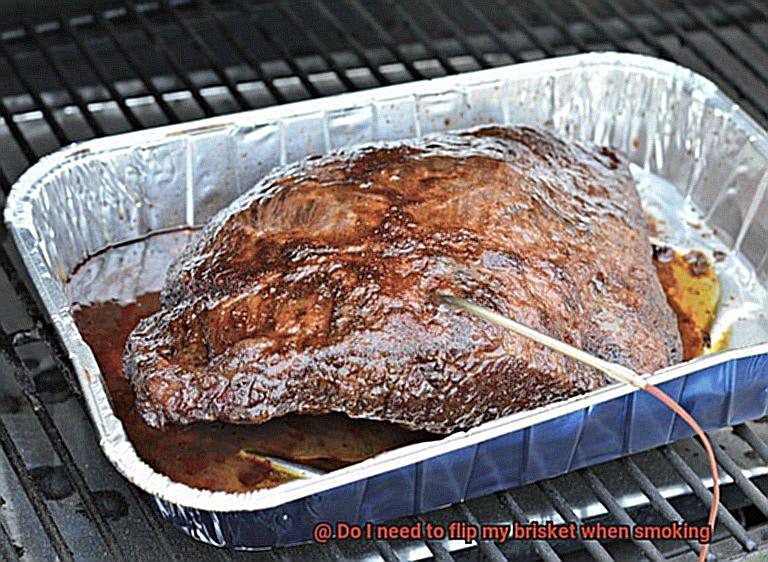
On the other hand, if you’re grilling with a more modern smoker like a pellet or electric one with even heat distribution, flipping might not be necessary. The heat is already doing its thing evenly throughout the chamber, so you can sit back and let the smoke work its magic.
But let’s say you decide to take the plunge and flip that brisket. Timing is everything, my friends. Typically, around the halfway point of the cooking time is when you want to make your move. By this time, your brisket should have developed a beautiful crust on one side, which will help it stay intact when you flip it.
Now here’s where things get a little tricky – flipping without losing those precious juices or messing up that gorgeous bark formation requires finesse. Grab a sturdy spatula or some barbecue tongs and gently lift and turn that brisket over. Be careful not to disturb the bark or let any juices escape.
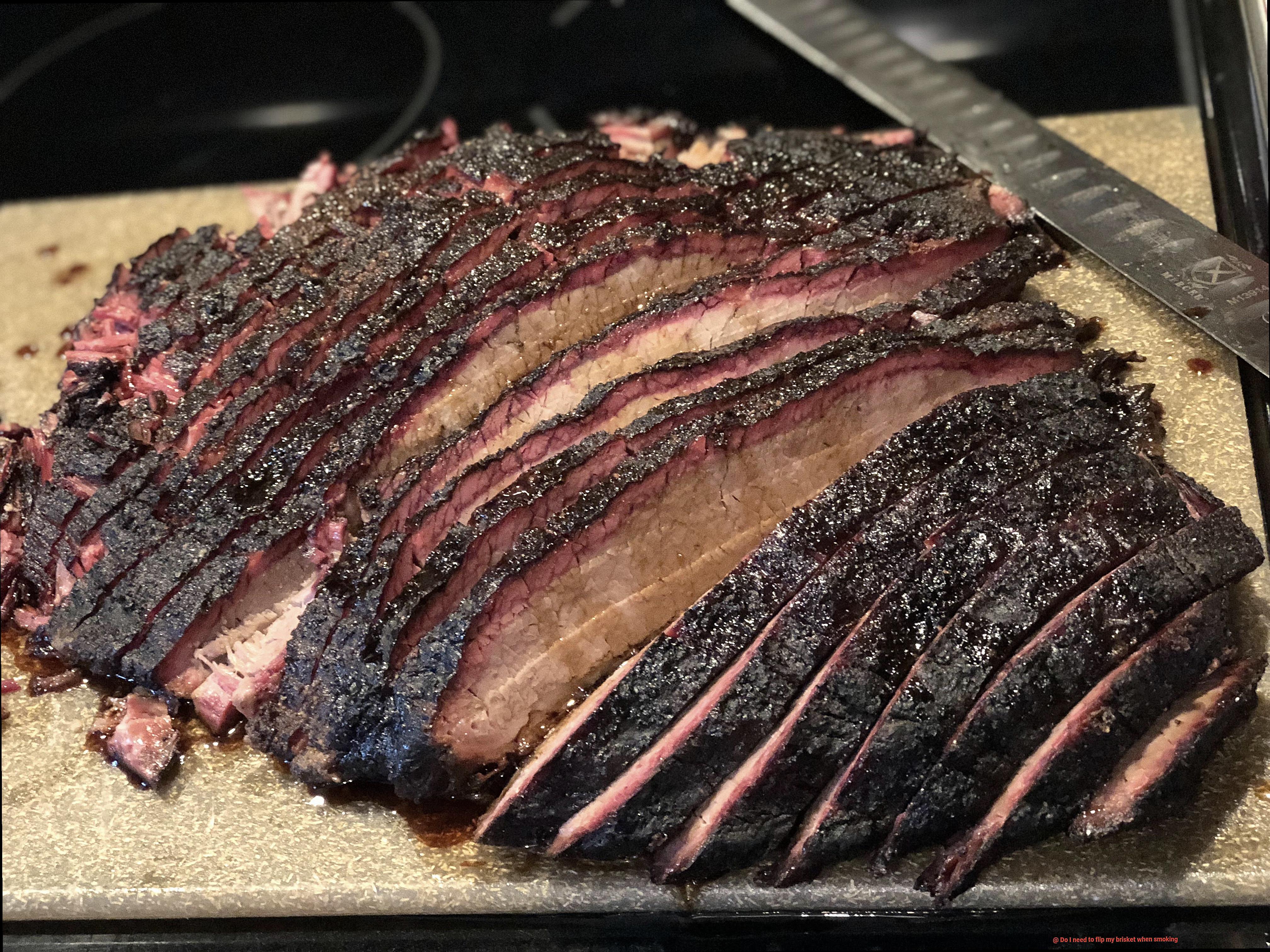
Keep an eye out for any hot spots in your smoker and adjust the position of the meat accordingly to ensure even cooking. After flipping, continue cooking until your brisket reaches the desired internal temperature.
But here’s the juicy secret – flipping is not mandatory. Many pitmasters have achieved mouthwatering results without ever flipping their briskets. It all comes down to personal preference and the specific circumstances of your cooking setup.
Tips for Flipping the Brisket
It’s time to dive into the world of smoking a brisket. But before you fire up the smoker, there’s an important technique you need to know about – flipping the brisket. In this blog post, we’ll explore why timing is crucial when flipping a brisket during smoking and provide you with expert tips to ensure a perfectly cooked and mouthwatering end result.
The Art of Even Cooking:
Picture this: you’re eagerly anticipating that first bite of tender, smoky brisket. But when you slice into it, you discover one side is dry and overcooked while the other is underdone. Don’t let this disappointment ruin your grilling experience. Flipping the brisket during smoking helps ensure even cooking, distributing heat and smoke evenly across both sides of the meat. This results in a more consistent texture and flavor throughout.
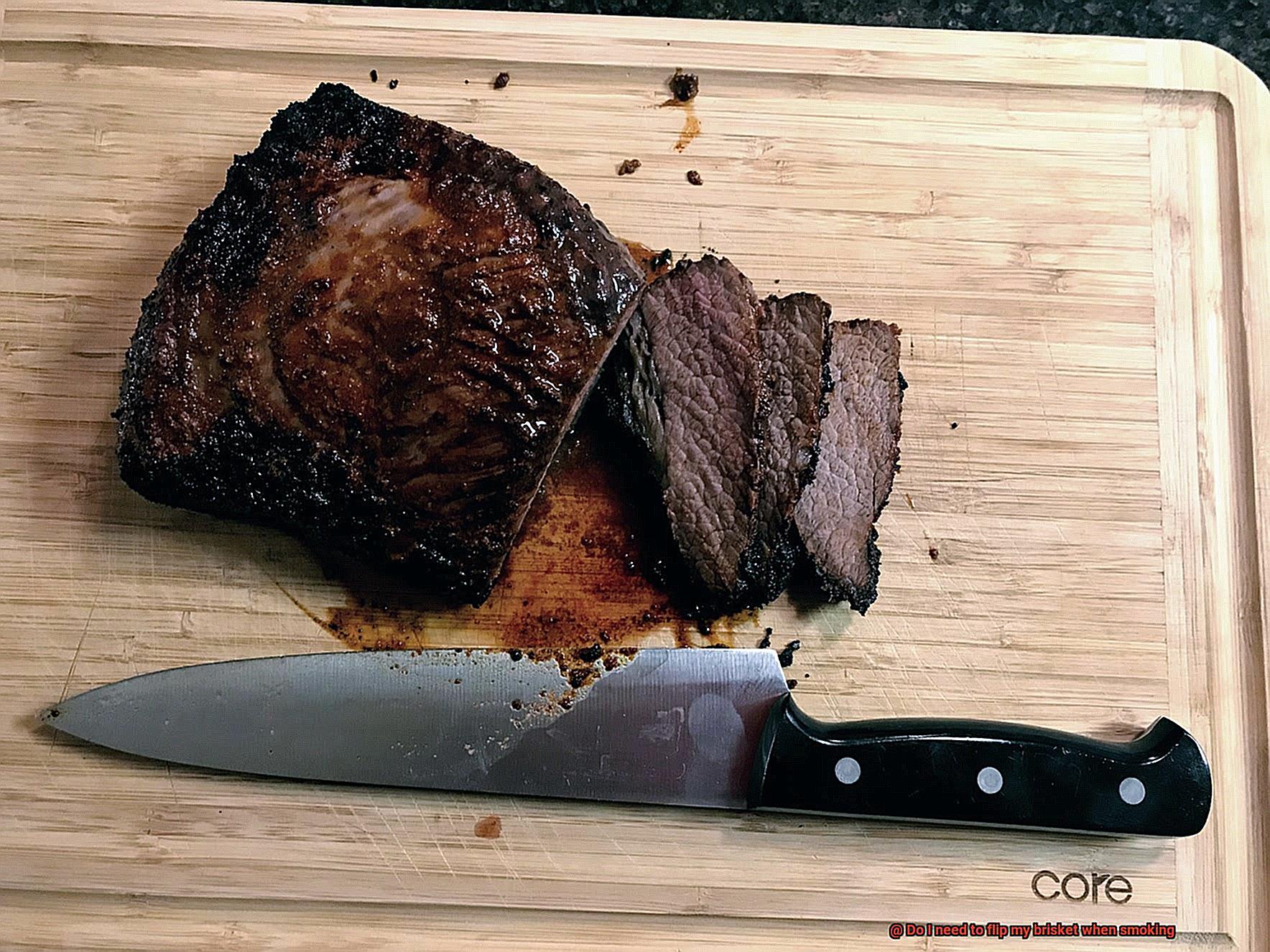
Timing is Key:
Timing is everything when it comes to flipping a brisket. Experts recommend flipping it around halfway through the estimated cooking time, usually around 4-6 hours. Keep in mind that factors such as brisket size and cooking method can influence this timeframe. By flipping at the right moment, you allow each side of the brisket to receive equal exposure to smoke and heat, preventing any burnt or undercooked spots.
Handle with Care:
When it’s time to flip the brisket, handle it with care. You don’t want to lose any precious juices or disturb the flavorful bark that has formed on the surface. Opt for sturdy tongs or a large spatula to delicately lift and turn the meat. This ensures minimal loss of moisture and preserves the beautiful crust that adds depth to your delicious creation.
The Double Wrap Technique:
For an extra boost of tenderness and juiciness, consider using the double wrap technique. This involves tightly wrapping the brisket in foil, flipping it onto a new sheet of foil, and placing it back on the smoker. The double layer of foil helps retain moisture and captures the flavorful juices, resulting in a mouthwatering brisket that melts in your mouth.
Rotate for Even Heat Distribution:
If your smoker has multiple levels or racks, you may need to rotate or rearrange the briskets during cooking. This ensures even heat distribution and prevents any hot spots from overcooking certain areas. However, always maintain the same orientation (fat side up) when moving or rotating the brisket to maintain its optimal flavor and tenderness.
How Often Should You Flip the Brisket?
Flipping the brisket while smoking is a common practice among pitmasters, and it serves a few important purposes. First and foremost, flipping ensures even cooking. By turning the brisket, you make sure that both sides are exposed to an equal amount of heat and smoke. This prevents one side from becoming overly charred while the other side remains undercooked.
But that’s not all. Flipping also helps distribute the fat evenly throughout the meat. This results in a juicier and more flavorful end product. So, if you’re aiming for that melt-in-your-mouth experience, flipping is definitely a step you don’t want to skip.
Now, let’s talk about timing. The ideal frequency of flipping can vary depending on factors like the size of the cut and your desired level of doneness. However, a general guideline is to flip the brisket after it has cooked for about half of its estimated total cook time. This allows both sides to get their fair share of heat and smoke without disrupting the formation of a delicious crust on the exterior.
When it comes to technique, be sure to use long-handled tongs or spatulas to avoid burning yourself or losing those precious juices. And remember, flipping should be done quickly and with care to minimize heat loss and temperature fluctuations within the smoker.
At the end of the day, how often you flip your brisket when smoking is a matter of personal preference and experimentation. Some pitmasters believe that flipping once is sufficient, while others prefer to flip multiple times for even cooking. It’s recommended to try different methods and techniques to determine what works best for your taste and cooking style.
Takeaways
After diving into the research and gathering key takeaways, we can offer some insight to help you make an informed decision.
First, let’s address the flip-flop debate. Seasoned pitmasters argue that leaving the brisket untouched throughout the smoking process is the way to go. This allows the fat cap to work its magic, rendering and basting the meat as it cooks. The result? A juicy and flavorful brisket that will have your taste buds doing a happy dance.
However, there are those who advocate for flipping halfway through the cooking time. Why? Flipping ensures even cooking and prevents one side of the brisket from drying out. Plus, it allows for better smoke penetration, resulting in a flavor explosion from all angles.
Now, let’s talk smokers. If you’re rocking a traditional offset smoker, where heat and smoke enter from one side, flipping that brisket might just be your secret weapon. It helps achieve more even heat distribution, ensuring that every inch of your meat gets the love it deserves. On the other hand, if you’re using a pellet or electric smoker with even heat distribution, flipping may not be as crucial.
Here’s the bottom line: flipping or not flipping your brisket boils down to personal preference and experience. It’s all about finding what works best for you. So don’t be afraid to get your hands dirty and experiment with different techniques. Remember, consistency in temperature and creating a moist cooking environment are key in achieving that mouthwatering smoked brisket.
In conclusion, while flipping your brisket during smoking isn’t a must-do, some pitmasters swear by it for various reasons. Whether you choose to flip or not, focus on maintaining consistent temperatures and creating an optimal cooking environment. With practice and a dash of experimentation, you’ll discover the method that brings out the best flavors for your taste buds.
Conclusion
In conclusion, when it comes to smoking a brisket, flipping it is not necessary.
The low and slow cooking method allows the meat to evenly cook and develop a delicious bark on all sides. Flipping the brisket can disrupt this process and potentially lead to uneven cooking.
Instead, focus on maintaining a consistent temperature and using a quality smoker that provides even heat distribution. Trust the process and resist the temptation to flip your brisket.
Let it rest, slice it against the grain, and savor every tender and flavorful bite.

